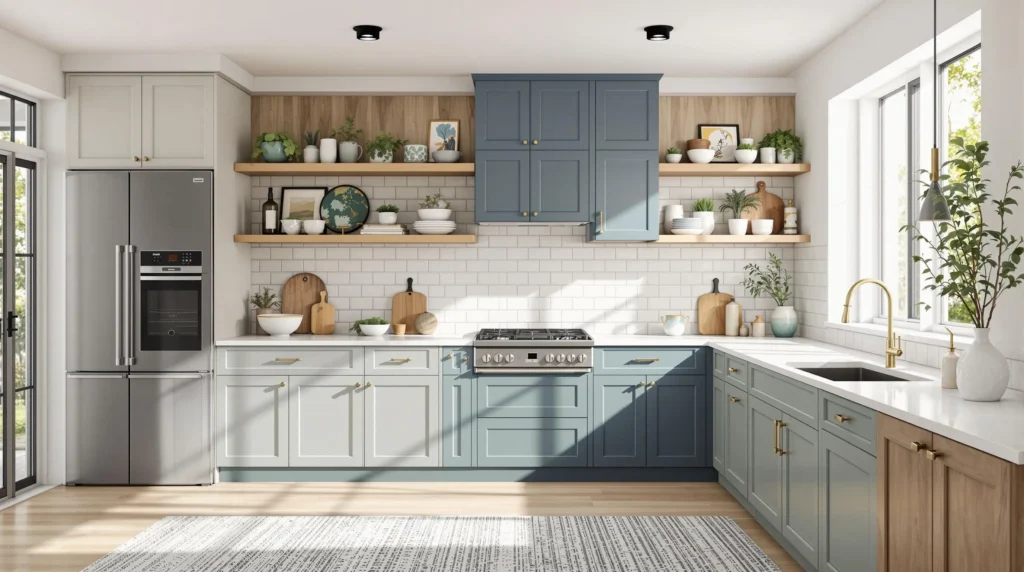We’ve all been there – scrubbing stubborn stains off kitchen cabinets that seem to highlight every fingerprint and food splatter. The good news? Your cabinet color choice can be your best ally in maintaining a clean-looking kitchen with minimal effort.
In our years of kitchen design experience, we’ve discovered that certain cabinet colors are masters of disguise when it comes to hiding dirt, crumbs, and everyday messes. These strategic color selections don’t just enhance your kitchen’s aesthetic – they’ll revolutionize your cleaning routine by making dirt less visible between deep cleans. Ready to transform your kitchen maintenance experience? Let’s explore the cabinet colors that work hardest for busy households.
10 Kitchen Cabinet Colors That Hide Dirt and Keep Your Space Looking Clean
Selecting the right cabinet color can dramatically reduce visible dirt and fingerprints in your kitchen. We’ve compiled our top picks for cabinet colors that naturally camouflage everyday messes while maintaining style and elegance.
1. Greige (Gray-Beige Blend)
Greige cabinets combine the warmth of beige with the sophistication of gray, creating a versatile neutral that excellently masks dust and minor spills. This color works brilliantly in both traditional and modern kitchens, pairing well with various countertop materials. Fingerprints virtually disappear on greige surfaces, making this shade ideal for busy households with children.
2. Medium Brown Tones
Medium brown cabinet finishes naturally conceal dirt and food splatters due to their varied wood grain patterns and depth of color. These warm tones create a cozy atmosphere while providing practical benefits for everyday use. Scratches and minor imperfections blend seamlessly into the natural variations of medium brown cabinetry, extending their pristine appearance between cleanings.
3. Slate Blue
Slate blue cabinets offer a designer look while providing excellent dirt-hiding properties. This muted blue tone has enough depth to mask water spots and fingerprints without showing them as obviously as lighter colors would. The subtle gray undertones in slate blue help neutralize the appearance of dust and kitchen grime on cabinet surfaces.
4. Olive Green
Olive green cabinetry combines earthy tones with a distinctive character that naturally conceals kitchen messes. This sophisticated color has enough depth and complexity to disguise minor stains and dirt accumulation. Cooking residue and fingerprints are far less noticeable on olive green surfaces compared to brighter or lighter cabinet colors.
5. Distressed Black
Distressed black cabinets provide dramatic style while offering superior dirt-hiding capabilities. The intentionally weathered finish masks new scratches, fingerprints, and accumulated grime between cleanings. Food splatters and cooking residue blend into the varied texture of distressed black, making daily maintenance significantly easier.
6. Taupe
Taupe cabinets deliver a subtle, sophisticated neutral that effectively conceals everyday kitchen dirt. This versatile color works with virtually any design style while providing practical benefits for busy families. Fingerprints and water spots become nearly invisible against taupe’s complex undertones, reducing the visible signs of a well-used kitchen.
7. Charcoal Gray
Charcoal gray cabinetry offers modern elegance while masterfully hiding kitchen messes. This deeper gray tone conceals fingerprints, water droplets, and dust better than lighter alternatives. The rich depth of charcoal creates a sophisticated backdrop that keeps your kitchen looking cleaner for longer periods between thorough cleanings.
8. Terra Cotta
Terra cotta cabinets bring warm, earthy tones to your kitchen while naturally disguising food splatters and dirt. This reddish-brown hue mimics natural clay, helping to absorb and hide the visual impact of everyday messes. Cooking residue and minor stains blend seamlessly into terra cotta’s rich, varied coloration.
9. Navy Blue
Navy blue cabinets offer timeless appeal while providing excellent dirt-concealing properties. This deep, rich color effectively hides fingerprints, water spots, and minor stains that would be immediately visible on lighter surfaces. Navy’s depth of color creates a sophisticated look that maintains its clean appearance even though daily kitchen activities.
10. Weathered Wood Finishes
Weathered wood cabinet finishes combine rustic charm with practical benefits for busy households. The intentionally distressed appearance and varied tones naturally camouflage new marks, scratches, and accumulated grime. Food residue and everyday dirt blend into the character of weathered wood, extending the time between necessary deep cleanings.
Understanding Why Cabinet Color Matters in Dirt Visibility

Cabinet colors play a crucial role in how visible dirt and grime appear in your kitchen. The right color choice can significantly reduce the appearance of everyday messes, making your kitchen look cleaner with less maintenance.
The Science of Light Reflection and Dirt Perception
Dark cabinet colors naturally absorb more light, making fingerprints, smudges, and stains less noticeable on their surfaces. When light hits darker surfaces like deep browns or rich greens, it’s absorbed rather than reflected, effectively concealing imperfections that would be obvious on lighter cabinets. Lighter colors do the opposite – they reflect more light, which unfortunately highlights every speck of dirt and fingerprint that lands on them. Textured finishes or cabinets with visible wood grain offer additional camouflage benefits by creating visual complexity that breaks up the appearance of dirt particles and smudges.
High-Traffic Kitchen Considerations
For busy kitchens that see constant activity, choosing the right cabinet color becomes even more important:
- Dark Greens work exceptionally well in high-traffic areas, with medium shades like sage and olive effectively hiding cooking splatters while adding a natural, calming presence.
- Deep Browns and medium wood stains such as oak and walnut provide excellent concealment for fingerprints and minor stains without sacrificing style.
- Vibrant Dark Paints including emerald green and navy blue add dramatic flair while keeping maintenance requirements low by hiding everyday messes.
- Neutral Tones remain popular even though showing dirt more readily, though they’re often chosen for their timeless appeal rather than maintenance benefits.
We’ve found that families with young children or those who cook frequently benefit most from selecting cabinet colors strategically, as these environments typically generate more messes that require frequent cleaning.
Medium-Tone Greige: The Perfect Balance of Warmth and Dirt Concealment
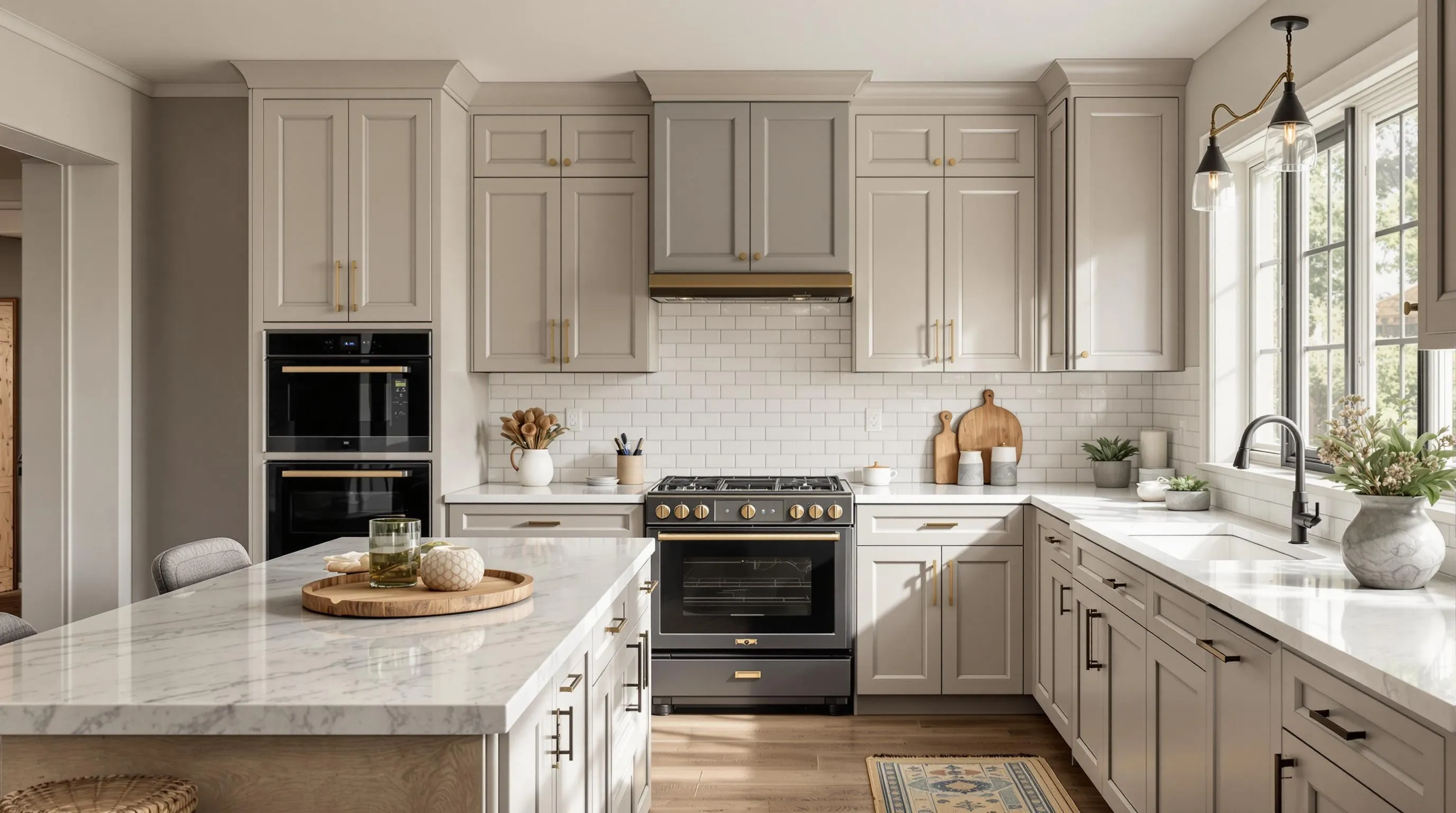
Greige cabinets offer homeowners the best of both worlds: the warmth of beige and the sophistication of gray, all while masterfully concealing everyday kitchen messes. This versatile neutral has become increasingly popular in kitchen design for its practical ability to hide fingerprints, food splatters, and dust without sacrificing style.
Styling Tips for Greige Cabinets
Creating a stunning kitchen with greige cabinets starts with understanding how to leverage this versatile color. Greige works beautifully as a neutral backdrop, allowing other elements in your kitchen to take center stage. Your countertops, backsplash, and statement appliances can truly shine against greige cabinetry without competing for attention.
Design professionals recommend pairing greige cabinets with contrasting hardware for maximum impact. Matte black pulls create a modern edge, while brass or copper fixtures add warmth and elegance. The adaptability of greige means it transitions seamlessly between traditional, transitional, and contemporary kitchen designs.
Natural lighting greatly affects how greige appears, so consider your kitchen’s exposure when selecting the perfect shade. North-facing kitchens benefit from warmer greige tones to counteract cool lighting, while south-facing spaces can handle cooler greige variations without appearing too stark.
Best Greige Paint Options for Cabinets
Selecting the right greige shade depends on your design preferences and existing kitchen elements. Warm greige options that lean more toward beige create inviting, cozy kitchen spaces while still effectively masking dirt and smudges. These warmer variations complement wood tones and natural stone beautifully, creating a harmonious kitchen palette.
Cool greige shades trending toward gray offer a more contemporary aesthetic while maintaining excellent dirt-hiding properties. These sophisticated colors pair exceptionally well with stainless steel appliances and concrete or quartz countertops. The slight gray undertone helps disguise fingerprints and cooking residue, making maintenance significantly easier.
Semi-gloss and satin finishes strike the ideal balance for greige cabinets—providing enough sheen to allow for easy cleaning without highlighting imperfections. These finishes enhance greige’s natural ability to conceal everyday kitchen messes while maintaining a polished appearance that elevates your entire kitchen design.
Rich Navy Blue: A Sophisticated Choice for Disguising Grime

Navy blue cabinets offer a sophisticated design choice that excels at hiding everyday kitchen messes. This rich, dark color effectively masks fingerprints, smudges, and minor stains that would be immediately visible on lighter cabinet finishes.
Complementary Hardware for Navy Cabinets
Brass or gold hardware creates a stunning contrast against navy blue cabinets, instantly elevating your kitchen’s aesthetic appeal. These warm-toned metals pop against the cool depth of navy, establishing a luxurious and timeless look that complements various kitchen styles. Polished finishes work particularly well with navy cabinets, creating reflective accents that draw the eye while highlighting the cabinet color’s rich undertones. When selecting hardware shapes, both traditional and modern designs pair beautifully with navy blue, allowing you to customize the look based on your overall kitchen theme.
Maintenance Tips for Dark Blue Finishes
Regular maintenance with a damp cloth prevents dust and grime from accumulating on navy cabinets, preserving their pristine appearance. Using gentle cleaners specifically formulated for your cabinet’s finish type helps maintain the color’s richness without causing damage to the surface. Durable stain-resistant coatings provide essential protection against kitchen spills and splatters, making cleanup significantly easier in busy cooking spaces. Semi-gloss or satin finishes offer practical benefits for navy cabinets by reducing the visibility of fingerprints while still providing depth to the color. These finishes strike the perfect balance between being easy to clean and hiding inevitable kitchen messes, making navy blue an excellent choice for high-traffic kitchens where visible stains are a concern.
Warm Taupe: The Understated Dirt-Masking Neutral
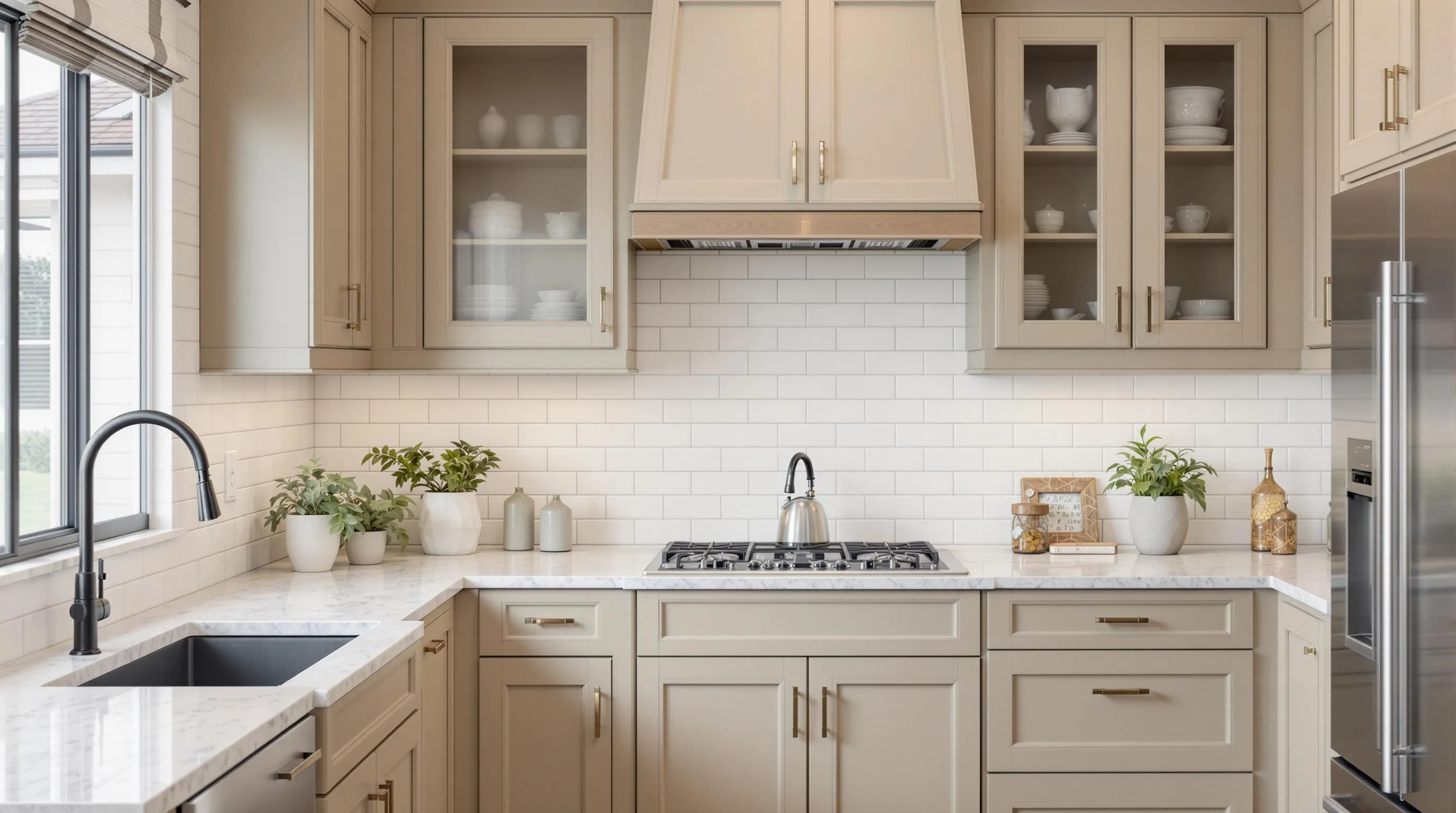
Taupe’s muted, warm undertones make it exceptionally effective at concealing dust and smudges compared to brighter neutral tones. This versatile color works beautifully in both traditional and contemporary kitchen designs while offering practical benefits for busy households.
Pairing Taupe with Countertops and Backsplashes
Taupe cabinets create a harmonious foundation when paired with carefully selected countertops and backsplashes. For countertops, we recommend quartz or marble in white, beige, or gray tones to maintain a cohesive, low-maintenance kitchen aesthetic. These combinations not only look sophisticated but also create a practical environment where minor spills and stains won’t immediately demand attention. Subway tiles in off-white or light gray provide an ideal backsplash option alongside taupe cabinetry, offering subtle contrast without overwhelming the space. Many designers favor this pairing because it creates visual interest while maintaining the dirt-masking properties that make taupe so practical for everyday use.
Popular Taupe Cabinet Finishes
Several taupe variations offer excellent dirt-hiding capabilities while providing distinct aesthetic options for your kitchen. Mushroom taupe delivers a perfect gray-beige blend that naturally conceals minor imperfections and everyday kitchen messes. Greige finishes combine the sophistication of gray with beige’s warmth, creating a modern, dirt-forgiving cabinet color that works exceptionally well in high-traffic kitchens. Taupe stain applications on wood cabinets introduce subtle grain textures that further help disguise wear and tear from daily use. Satin or semi-gloss finishes complement these taupe variations beautifully while ensuring easy cleaning and maintenance. Unlike matte finishes that tend to accentuate streaks and fingerprints, these mid-sheen options provide the perfect balance of practicality and style for busy kitchens.
Sage Green: Nature-Inspired Color That Camouflages Spots
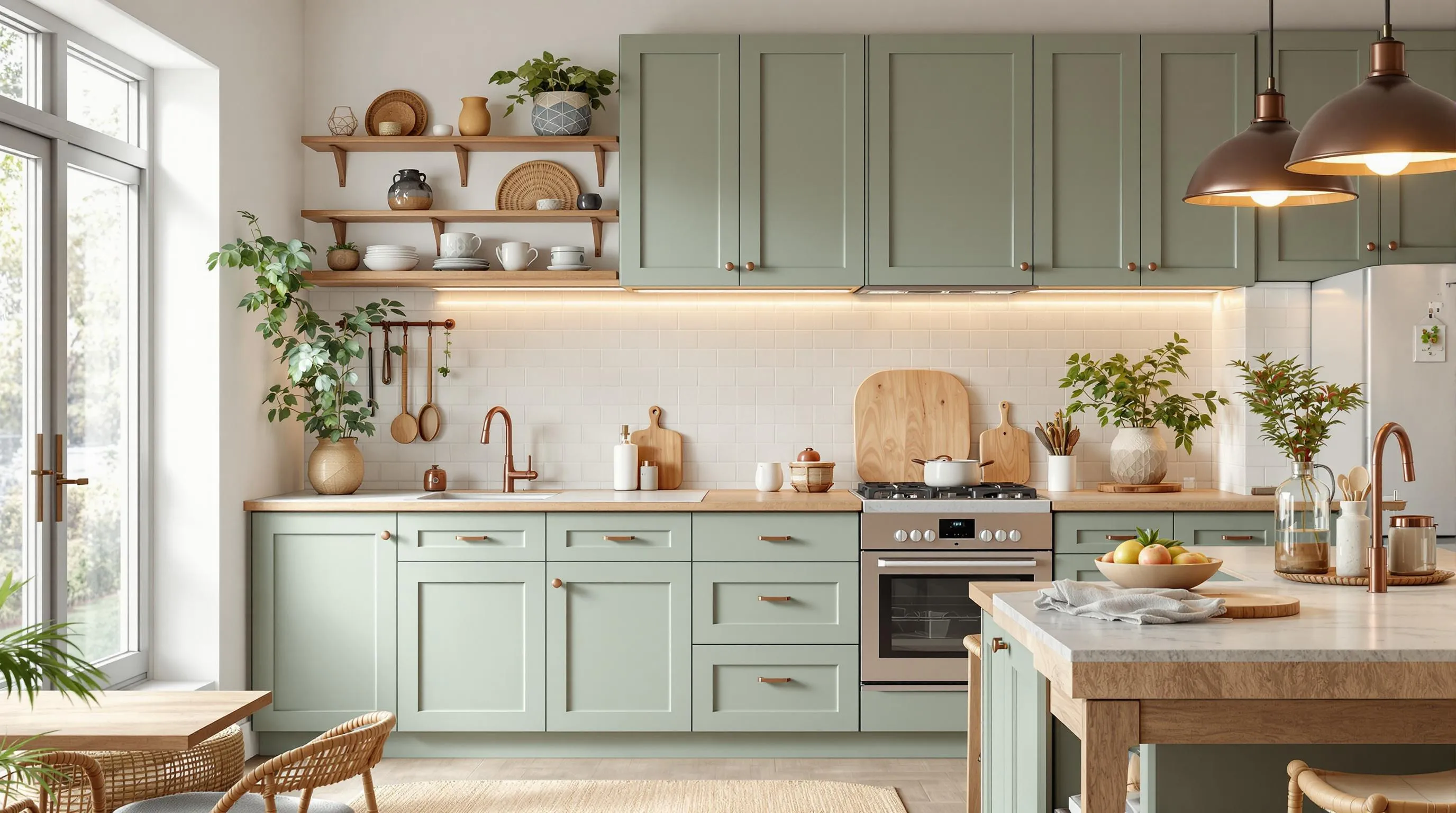
Sage green cabinets strike a perfect balance between style and functionality in modern kitchens. This earthy, muted tone offers a natural aesthetic while providing moderate dirt-hiding capabilities compared to other color options.
Creating a Cohesive Kitchen with Sage Cabinets
Sage green cabinets work exceptionally well in nature-inspired kitchen designs. We recommend pairing them with natural materials like wood countertops or stone surfaces to enhance their organic appeal. Natural wood flooring complements sage cabinetry beautifully, creating a warm, inviting atmosphere throughout the space. Consider adding woven elements, botanical accents, or copper fixtures to further emphasize the nature-inspired theme. For backsplashes, white subway tiles or cream-colored natural stone create a lovely contrast against the soft green cabinet color. Many designers successfully combine sage cabinets with open shelving featuring wooden elements to maintain an airy, natural feel while showcasing decorative items that bring personality to the kitchen.
Best Lighting for Sage Green Kitchens
Lighting plays a crucial role in improving sage green cabinets while minimizing the visibility of dirt and smudges. Warm, soft lighting creates a cozy ambiance that complements the natural qualities of sage green while helping to disguise imperfections. Task lighting under cabinets illuminates workspaces effectively without creating harsh shadows that might highlight fingerprints or spots. Pendant lights with warm-toned bulbs hanging over islands or dining areas cast a flattering glow on sage cabinetry. Natural daylight through windows or skylights brings out the true beauty of sage green’s undertones but should be balanced with proper window treatments to control intense direct sunlight. Avoid harsh, direct lighting fixtures that can highlight cabinet imperfections and instead opt for diffused lighting answers that create a more forgiving environment.
Charcoal Gray: The Modern Alternative to Black That Hides Everything

Charcoal gray cabinets deliver a sophisticated, modern aesthetic while masterfully concealing dirt, smudges, and fingerprints. With its mid-to-low Light Reflectance Value (LRV), charcoal offers the perfect balance between dramatic black and more forgiving darker tones that naturally camouflage kitchen messes.
Preventing Fingerprints on Charcoal Surfaces
Selecting the right finish is crucial when choosing charcoal cabinets for your kitchen. Satin or semi-gloss finishes minimize visible marks compared to matte or high-gloss options, which can reveal fingerprints more readily. When cleaning charcoal surfaces, microfiber cloths paired with mild cleaners prevent streaking and maintain the cabinet’s sleek appearance. Cabinet material also plays a important role in disguising imperfections—textured or wood-grain finishes mask everyday kitchen messes far better than smooth surfaces. These texture variations create visual interest while serving the practical purpose of concealing the inevitable smudges that occur in busy kitchens.
Design Elements That Complement Charcoal Cabinets
Countertops in white, cream, or warm beige quartz or marble create stunning contrast against charcoal cabinetry while brightening your kitchen space. Backsplash options like subway tiles in soft neutrals or metallic accents including brushed brass or stainless steel help balance the depth of charcoal with lighter elements. Hardware choices such as matte black for a seamless look or brass and chrome for striking contrast can elevate the entire kitchen design. Lighting deserves special attention with charcoal cabinets—under-cabinet fixtures and strategically placed pendant lights prevent the dark tone from absorbing too much light and making the space feel smaller. This thoughtful combination of design elements ensures your charcoal gray kitchen remains both stylish and practical for daily use.
Distressed Wood Finishes: When Texture Helps Hide Imperfections
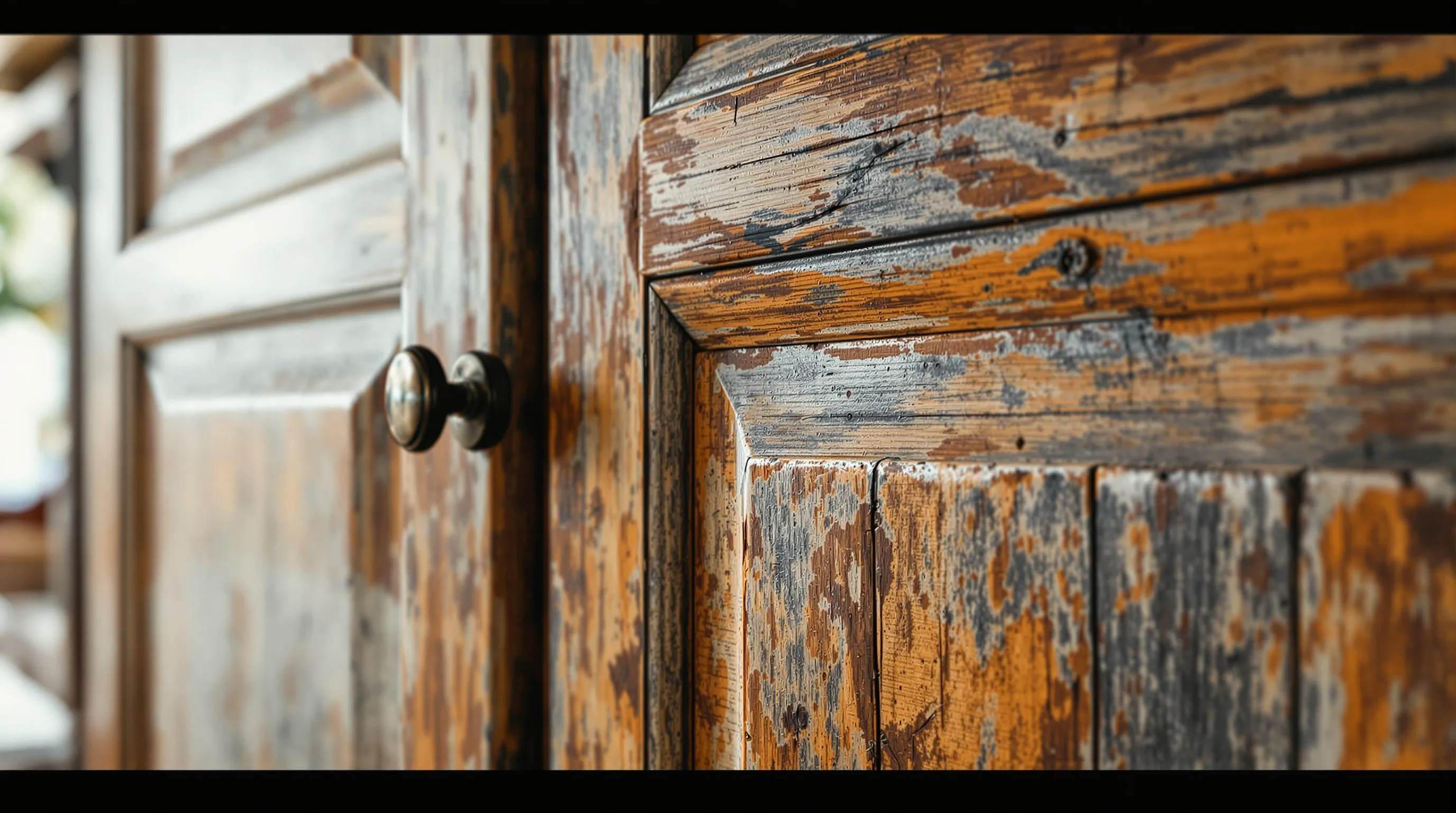
Distressed wood finishes offer a practical solution for busy kitchens where dirt and fingerprints are inevitable. These textured surfaces naturally mask imperfections by incorporating intentional wear marks, scratches, and uneven coloring that blend with everyday smudges and dirt.
Selecting the Right Wood Grain Patterns
Wood grain patterns play a crucial role in concealing kitchen messes and dirt accumulation. Oak and hickory cabinets with prominent grain patterns naturally disguise fingerprints and small stains within their textural variations. Pine offers a softer wood option that can be easily distressed to create depth that hides imperfections. Reclaimed wood brings natural wear patterns that make new dirt virtually indistinguishable from the existing character marks. Quarter-sawn woods display distinctive ray flecks and ribboning that create visual interest while masking smudges effectively. We recommend choosing wood species with natural color variations for maximum dirt-hiding benefits, as these multi-toned surfaces naturally camouflage spots and stains within their diverse coloration.
Maintaining Distressed Cabinet Finishes
Regular cleaning with gentle products preserves the intentional character of distressed finishes while removing actual dirt. Soft microfiber cloths work best for routine dusting and cleaning without damaging the textured surface. Harsh chemicals should be avoided as they can strip away the finish that creates the distressed appearance. Wood-exact cleaners applied sparingly help maintain the cabinet’s protective seal without compromising the weathered look. Touch-up kits designed for distressed finishes allow for spot treatments of areas that become too worn through daily use. Semi-gloss or satin protective topcoats offer the ideal balance between easy cleaning and maintaining the authentic distressed appearance. Professional resealing every few years ensures your distressed cabinets continue to effectively hide dirt while remaining protected from moisture damage.
Muted Terra Cotta: Warm Tones That Conceal Daily Messes

Muted terra cotta cabinets offer a distinctive advantage in busy kitchens by naturally concealing dirt and smudges thanks to their warm, rich undertones. This earthy hue provides both practical functionality and timeless appeal that works beautifully in various kitchen styles.
Regional Design Styles That Showcase Terra Cotta
Mediterranean kitchens traditionally embrace terra cotta as a signature element, creating warm and inviting spaces that reflect coastal European charm. Southwestern design aesthetics incorporate these warm tones to evoke desert landscapes and cultural heritage, often paired with textural elements like wrought iron accents. Tuscan-inspired kitchens feature terra cotta prominently, creating rustic elegance that feels both sophisticated and lived-in. Farmhouse designs have recently adopted muted terra cotta tones for a fresh twist on country style, offering warmth without overwhelming the space. Spanish colonial kitchens showcase these hues as part of their authentic character, complementing architectural features like arched doorways and ornate tilework.
Color Combinations for Terra Cotta Cabinets
Earthy greens create a natural harmony when paired with terra cotta cabinets, mimicking colors found in nature and producing a soothing, organic aesthetic. Creamy whites balance the warmth of terra cotta perfectly, adding brightness to the space while maintaining the cozy atmosphere these cabinets create. Warm beiges complement terra cotta’s rich tones, establishing a cohesive color story that feels intentional and inviting throughout the kitchen. Deep blues offer striking contrast against terra cotta, creating visual interest while still maintaining a cohesive palette inspired by natural elements. Soft grays provide a contemporary counterpoint to terra cotta’s warmth, modernizing this traditional color while preserving its dirt-hiding capabilities. Matte black hardware and fixtures stand out beautifully against terra cotta cabinets, adding definition and sophistication that enhances the overall design.
Two-Tone Cabinet Strategies: Strategic Color Placement for High-Touch Areas
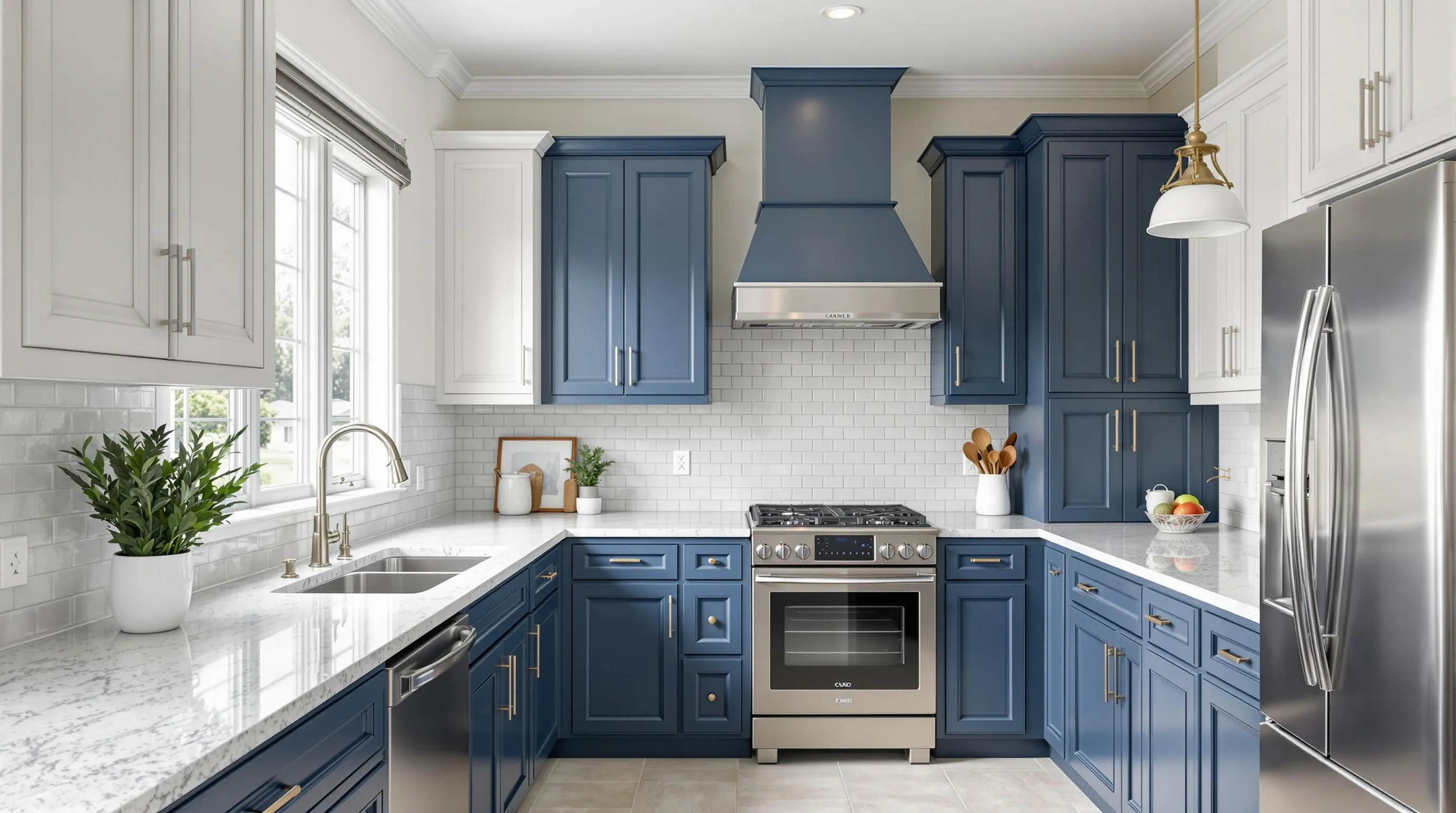
Two-tone cabinets offer both aesthetic appeal and practical benefits when it comes to hiding dirt and maintaining a clean kitchen appearance. By strategically placing colors according to usage patterns, you can create a kitchen that’s both beautiful and functional.
Lower vs. Upper Cabinet Color Considerations
Lower cabinets experience significantly more contact, making them prime candidates for darker, dirt-concealing finishes. Navy blue and espresso brown work exceptionally well for base cabinets, effectively hiding scuffs, spills, and fingerprints from daily use. These darker tones create a solid foundation that can withstand the rigors of kitchen activity without constantly showing smudges.
Upper cabinets benefit from lighter colors like off-white, cream, or light gray, which help reflect light and create an airy feel in the kitchen. This strategic color division follows both design principles and practical maintenance considerations. Light upper cabinets prevent the space from feeling top-heavy while maintaining visual openness.
The contrast between dark lower and light upper cabinets creates a balanced visual weight throughout the kitchen. Many designers recommend maintaining a 60-30-10 color ratio to avoid overwhelming contrasts while still achieving a cohesive look. This approach delivers optimal dirt-hiding capabilities precisely where you need them most.
Transitional Elements for Two-Tone Kitchens
Hardware selections play a crucial role in unifying two-tone cabinet designs. Consistent finishes like brushed nickel or matte black across both cabinet colors create visual continuity throughout the space. These hardware elements serve as connecting points that tie your color scheme together.
Countertops function as natural transitional elements between upper and lower cabinets. Neutral quartz or stone countertops with subtle veining can effectively bridge the color gap between contrasting cabinet sections. Materials that incorporate both your chosen cabinet colors create a seamless flow between the different zones.
Backsplashes offer another opportunity to connect your two-tone cabinet colors. Mid-tone tile selections or slabs that incorporate elements from both your upper and lower cabinet colors create a cohesive transition. Textured or patterned backsplashes can also help distract from any dirt or splatter marks that inevitably occur in cooking areas.
Flooring choices should complement rather than compete with your two-tone cabinet strategy. Selecting flooring with subtle variations allows your strategically placed cabinet colors to remain the focal point while providing another dirt-concealing surface. Wood tones or textured tile in mid-range colors work particularly well in busy kitchens with two-tone cabinets.
Textured Cabinet Finishes That Naturally Disguise Dirt

Textured cabinet surfaces offer an ingenious solution for keeping your kitchen looking cleaner with less effort. These finishes, including distressed wood, wire-brushed textures, and beadboard designs, naturally minimize dirt visibility by breaking up light reflection patterns. Their irregular surfaces and natural grain variations effectively camouflage minor scratches, dust, and everyday smudges that would be immediately noticeable on smoother finishes.
Benefits of Textured vs. Smooth Cabinet Surfaces
Textured cabinet surfaces excel at hiding the inevitable signs of daily kitchen use. These surfaces mask minor imperfections, scratches, and wear patterns that accumulate over time, making them ideal choices for high-traffic kitchens where cabinets face constant touching. The irregular patterns create visual interest while serving the practical purpose of disguising fingerprints that would otherwise require constant cleaning.
Smooth cabinet surfaces, while elegant and timeless, reveal every imperfection with unforgiving clarity. They highlight fingerprints, dust particles, and minor scratches almost immediately after cleaning. Maintaining their pristine appearance demands frequent wiping and polishing, creating additional work in busy households where time for cleaning might be limited.
Families with young children will particularly appreciate textured finishes, as they can withstand the inevitable touches of small, sometimes sticky hands without showing evidence of every interaction. Cooking enthusiasts who use their kitchens intensively will also find that textured cabinets maintain their aesthetic appeal with far less maintenance than their smooth counterparts.
Cleaning and Maintenance for Textured Cabinets
Proper tools make all the difference when cleaning textured cabinet surfaces. Soft-bristle brushes and microfiber cloths reach into crevices effectively, removing dust and debris that might accumulate within the texture’s natural grooves. These tools clean without damaging the intentional texture that gives your cabinets their character and dirt-hiding properties.
Gentle cleaners preserve both the finish and appearance of textured cabinets. Mild soap answers work well for regular cleaning, while a simple vinegar-water mixture (mixed in a 1:1 ratio) offers an effective natural alternative that cuts through grease without harming surfaces. Avoid harsh chemicals that might strip protective finishes and diminish the cabinet’s dirt-masking capabilities.
Establishing a regular maintenance schedule prevents buildup in textured grooves. Dusting weekly removes surface particles before they can settle deeply into textures, while monthly deep cleaning addresses any accumulated grime that might eventually become visible. This proactive approach maintains the cabinet’s clean appearance with minimal effort.
Protective treatments extend the life and performance of textured cabinets. Applying cabinet wax or an appropriate sealant annually reinforces the dirt-resistant properties of satin or semi-gloss finishes. This maintenance step creates an additional barrier against dirt and moisture, improving the textured surface’s natural ability to disguise everyday kitchen messes.
Practical Tips for Maintaining Any Cabinet Color Choice
Choosing the right cabinet color is only half the battle in maintaining a clean-looking kitchen. We’ve explored many color options that naturally hide dirt while improving your kitchen’s aesthetic appeal. From rich navy and charcoal gray to warm taupe and textured finishes each offers unique benefits for busy households.
Remember that regular maintenance remains essential regardless of your color choice. A quick daily wipe-down paired with weekly deeper cleaning will keep your cabinets looking their best. Consider applying protective coatings on high-touch areas and investing in quality cabinet hardware that’s easy to clean.
By strategically selecting cabinet colors that work with your lifestyle not against it you’ll spend less time cleaning and more time enjoying your beautiful kitchen. The perfect cabinet color balances style practical maintenance and your personal design preferences.
Frequently Asked Questions
What cabinet colors are best at hiding dirt and stains?
Medium brown tones, greige, slate blue, olive green, distressed black, taupe, charcoal gray, terra cotta, navy blue, and weathered wood finishes excel at hiding dirt. These colors effectively camouflage fingerprints, smudges, and everyday kitchen messes, making them ideal choices for busy households where maintaining a clean appearance is important without constant cleaning.
Why do dark cabinet colors hide dirt better than light ones?
Dark cabinet colors absorb more light, making fingerprints and stains less noticeable. Light colors reflect more light, highlighting imperfections and dirt. The science of light reflection explains why darker cabinets (like navy or charcoal) can go longer between cleanings while maintaining their appearance, while white or light-colored cabinets immediately show every smudge.
Are textured cabinet finishes better for hiding dirt than smooth ones?
Yes, textured cabinet finishes significantly outperform smooth surfaces at hiding dirt. Finishes like distressed wood, wire-brushed textures, and beadboard break up light reflection patterns, naturally camouflaging fingerprints, minor scratches, and smudges. Smooth cabinets reveal every imperfection, while textured options require less frequent cleaning and maintenance.
What is the best cabinet color for families with young children?
Dark greens, deep browns, and navy blue are excellent choices for families with young children. These colors effectively conceal fingerprints, food splashes, and other inevitable messes. Medium-tone greige and distressed finishes also perform well. Two-tone strategies with darker colors on lower cabinets (where children touch most) can be particularly effective.
How does greige perform as a dirt-hiding cabinet color?
Greige performs exceptionally well at hiding dirt while offering versatile style. This medium-tone color—a blend of gray and beige—provides enough depth to mask everyday smudges and dust while creating a warm, sophisticated look. Greige cabinets work with various design styles and can be paired with contrasting hardware for added impact.
What cabinet hardware works best with navy blue cabinets?
Brass or gold hardware creates a striking contrast with navy blue cabinets, enhancing their sophisticated appearance. Silver, brushed nickel, and matte black also work well depending on your kitchen’s overall design. The hardware’s finish can dramatically impact the cabinet’s ability to hide fingerprints, with matte finishes generally performing better than high-polish options.
What countertops pair well with taupe cabinets?
Quartz or marble countertops in white, beige, or gray tones complement taupe cabinets beautifully. The subtle warmth of taupe creates a cohesive look with these materials while maintaining a low-maintenance aesthetic. For backsplashes, off-white or light gray subway tiles work well, enhancing the dirt-masking properties of the entire kitchen design.
How should two-tone cabinets be arranged for maximum dirt-hiding?
For maximum dirt-hiding benefits, use darker colors (navy, charcoal, espresso) on lower cabinets where they’ll conceal scuffs and spills better. Reserve lighter colors for upper cabinets to create visual space and brightness. This strategic color placement optimizes both aesthetics and practicality, addressing the areas most susceptible to visible dirt.
What finishes are recommended for kitchen cabinets that hide dirt?
Semi-gloss and satin finishes offer the best balance between cleanability and dirt-hiding capabilities. These finishes are easier to wipe down than flat/matte finishes while not highlighting imperfections as much as high-gloss options. For textured cabinets, lower-sheen finishes further enhance their natural ability to disguise dirt and smudges.
How should textured cabinet finishes be cleaned and maintained?
Clean textured cabinets with soft-bristle brushes to reach crevices without damaging the surface. Use gentle, non-abrasive cleaners and avoid harsh chemicals that can strip protective coatings. Establishing a regular maintenance schedule and occasionally applying protective treatments will preserve both their character and dirt-hiding properties while extending their lifespan.

